Great bears! Teddy bears, famous bears, bears in the sky, bear stories, bear science, and the peculiar history of Gummi Bears. AND a recipe for Bear Cupcakes.
Table of Contents
TEDDY BEARS

|
In Susan Meyers’s Bear in the Air (Abrams Books for Young Readers, 2010), Bear bounces out his owner’s stroller and is grabbed by a dog who dashes off with him down the beach. Bear has a lot of adventures, including a dive with a seal and a flight with a pelican, before he finally makes it back home. A sweet story with charming flapper-era illustrations. For ages 2-5. |
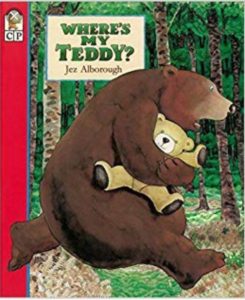
|
Jez Alborough’s Where’s My Teddy? (Candlewick, 1994) is a comedy of mistaken identities. Eddie, braving the woods at night to search for Freddie, his lost teddy bear, instead comes upon a real bear’s enormous teddy. (“How did you get to be this size?” he wonders.) At the same time, in another part of the forest, the upset bear has found Freddie, and believes it to be his own teddy, now shrunk dismayingly small. (It all sorts itself out nicely in the end.) For ages 3-7. |
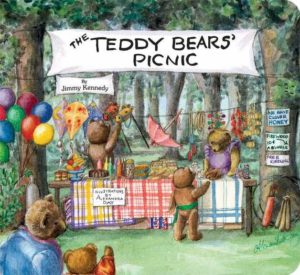
|
Jimmy Kennedy’s picture book The Teddy Bears’ Picnic (Aladdin, 2000) is an illustrated version of the catchy 1907 song. (“If you go down in the woods today/You’re sure of a big surprise…”) For ages 3-7. |
| Listen to the song The Teddy Bear’s Picnic | |
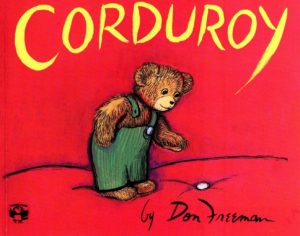
|
The star of Don Freeman’s Corduroy (Puffin, 1976) is an endearing teddy bear in green overalls who has lost a button. Once all the shoppers have left his department store at night, off he goes in search of it, having misadventures with escalators and lamps along the way. Eventually, still button-less, he’s nabbed and returned to his shelf by the night watchman – but the story ends happily when a little girl loves him, buys him, takes him home, and sews on a new button. There’s a sequel: A Pocket for Corduroy. For ages 3-8. |
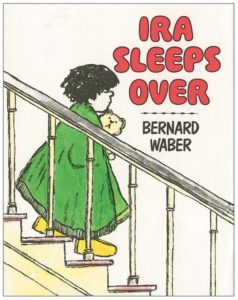
|
In Bernard Waber’s Ira Sleeps Over (Houghton Mifflin Harcourt, 1975), Ira is thrilled to be spending the night at his friend Reggie’s house, until his sister raises the question of Ira’s teddy bear. What will Reggie think of Ira when he finds out that he sleeps with a teddy bear? And that it’s named Tah Tah? However, it turns out that Ira’s not the only kid with a teddy bear. A delightful read for ages 4-8. |
teddy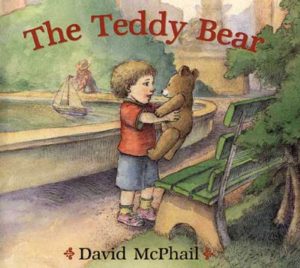
|
In David McPhail’s The Teddy Bear (Square Fish, 2005), a little boy mistakenly leaves his beloved teddy bear behind in a restaurant. The bear is tossed in the trash and rescued by a homeless man, who comes to love him. Sometime later the little boy – the original owner – spots his bear, where the homeless man has left it propped on a park bench. At first he’s thrilled to have his bear back, but then – when he sees the homeless man’s distress – he gives him back the bear. A discussion promoter for ages 4-8. |
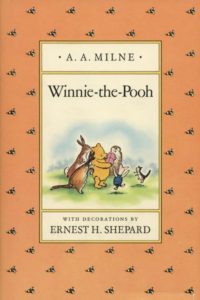
|
In A.A. Milne’s Winnie-the-Pooh, first published in 1926, the pudgy and lovable Bear of Very Little Brain was based on the teddy bear belonging to Milne’s son Christopher Robin. There are a lot of Disney Pooh books on the market; don’t fall for them. Get an edition with the original Ernest H. Shepard illustrations. Also see the sequel, The House on Pooh Corner. For ages 5 and up. |
| Open Culture has a rare 1929 recording of A.A. Milne reading a chapter of Winnie-the-Pooh (“In Which Pooh and Piglet Go Hunting and Nearly Catch a Woozle”). | |
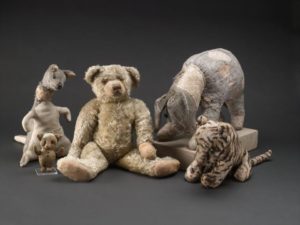 |
Learn about the REAL Winnie-the-Pooh at the New York Public Library. |
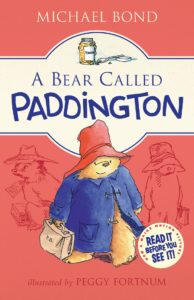
|
Michael Bond’s A Bear Called Paddington (HarperCollins, 2002), originally published in 1958, introduces the adorable but disaster-prone Paddington, first encountered by the Brown family in Paddington station, wearing a label around his neck reading “Please Look After This Bear.” He comes from Darkest Peru (sent to England by his Aunt Lucy who is now in a Home for Retired Bears); he wears a strange squashy hat; and he’s very fond of marmalade. Many sequels. For ages 5-9. |
| See the official Paddington Bear website for games and activities, information on the author and illustrators, Paddington postcards, and synopses of all the books. | |
 |
By Daisy Corning Stone Spedden, Polar the Titanic Bear (Little, Brown Books for Young Readers, 2001) is a story of family life in the Edwardian era culminating in the voyage of the ill-fated Titanic, all told from the point of view of a little boy’s stuffed bear. The book was written in 1913; the author and her family were Titanic survivors. Illustrated with paintings and photographs. For ages 8-12. |
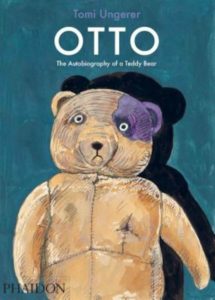
|
In Tomi Ungerer’s Otto: The Autobiography of a Teddy Bear (Phaidon Press, 2010), Otto is a bear who lives through hard times. His original owner is David, a Jewish boy growing up in Germany just before World War II. When David and family are taken away by the military, David passes Otto on to his best friend Oskar. When Oskar’s town is bombed, Otto is found on the battlefield, where an American soldier picks him up just in time to block a bullet. After the war, Otto goes home with the soldier to America, only to be stolen by a gang of delinquents. He’s rescued by an antiques dealer, where he’s eventually noticed in the dealer’s shop window by a visiting German – Oskar. The story of Oskar and Otto makes the newspapers, where it’s read by David. At the end of the book, the three friends are reunited. A difficult subject made accessible by a very gallant bear. For ages 8 and up. |
| For more resources, see The Holocaust. | |
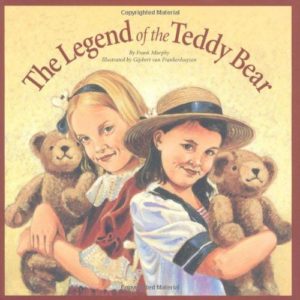
|
Frank Murphy’s The Legend of the Teddy Bear (Sleeping Bear Press, 2000) is the story of Theodore Roosevelt’s famous refusal to shoot a trapped bear – which so captivated the American public that stuffed bears thereafter were called “teddy bears.” For ages 5-10. |
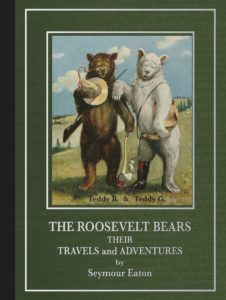 |
Seymour Eaton’s The Roosevelt Bears – respectively Teddy-B and Teddy-G – were the original “teddy bears,” first appearing in newspaper cartoons and books in the early 1900s. |
| From the Smithsonian, see The History of the Teddy Bear. |
